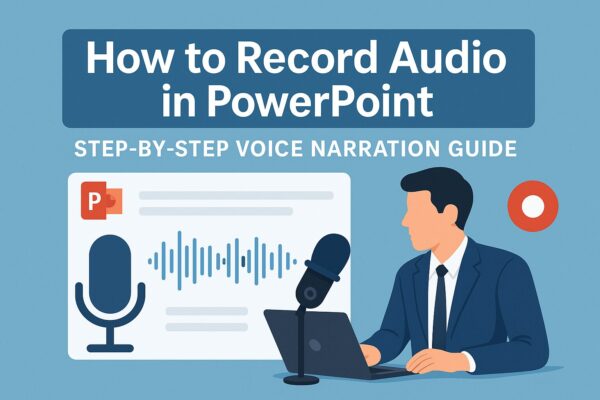
Have you ever created a presentation in PowerPoint and thought, “It would be so much clearer if I could explain it with my voice”?
Actually, PowerPoint has a built-in feature that lets you record narration directly onto your slides, making it easy to create voice-over presentations. In this article, we’ll walk you through the recording steps on Windows PowerPoint, highlight key points to watch out for, and offer solutions for common recording issues—all in a beginner-friendly way.
- 1 1. How do you record audio in PowerPoint?
- 2 2. How to record audio on each slide (individual recording)
- 3 3. How to record narration for the entire slideshow
- 4 4. How to save your narrated slides as a video (MP4)
- 5 5. Troubleshooting recording or playback issues
- 6 6. Tips and Recommended Settings for Better Recording
- 7 7. [Advanced] Insert External Audio Files into PowerPoint
- 8 8. How to Prepare Your Speaking Script Before Recording
- 9 9. Use Cases and Creative Applications of Narrated Slides
- 10 10. Troubleshooting Hacks When Recording Still Fails
- 11 Conclusion: Deliver Presentations That Speak for You
1. How do you record audio in PowerPoint?
There are two ways to record narration in PowerPoint:
- Record audio individually on each slide
- Record a full slideshow while advancing through slides (recording timing automatically)
If you’re a beginner, it’s recommended to start with the “record on each slide” method first.
Once recorded, your audio can be deleted or re-recorded, so feel free to practice and iterate.
2. How to record audio on each slide (individual recording)
Steps:
① Select the slide where you want to record in PowerPoint
② On the menu, go to “Insert” → “Audio” → “Record Audio”
③ Click the “Record” button and start speaking
④ When you’re done, click “Stop” and then “OK”
⑤ If a speaker icon appears on the slide, your recording was successful
The recorded audio will play automatically during the slideshow. You can select the speaker icon to adjust playback timing or volume.
3. How to record narration for the entire slideshow
If you want to add narration to multiple slides in one go, using the slideshow recording feature is very handy.
Steps:
① Go to the “Slide Show” menu → “Record Slide Show” → “Start from Beginning”
② The recording screen will appear, allowing you to record, pause, and advance through slides
③ As you speak, progress through the slides and record your narration
④ When finished, your audio will be automatically saved to each slide
You can also enable your webcam to record video along with the audio. This is useful for e-learning or video tutorials.
4. How to save your narrated slides as a video (MP4)
You can export your narrated slideshow as a video file.
Steps:
① Go to “File” → “Export” → “Create a Video”
② Choose the video quality and slide timing settings (default is usually fine)
③ Click “Create Video” and choose a save location
④ After a short wait, your MP4 file will be ready
This makes it easy to upload to YouTube or share within your organization. Your narration, slide transitions, and animations are all preserved.
5. Troubleshooting recording or playback issues
Recording audio can sometimes run into issues. Here are some common problems and how to fix them:
Common Issues & Fixes
| Issue | Cause | Fix |
|---|---|---|
| Cannot record | Microphone not detected | Allow microphone access in Windows settings |
| Audio is too quiet or muffled | Built-in mic is low quality or has low volume | Use an external mic or adjust volume settings |
| Playback doesn’t work | Recording not saved or speaker icon deleted | Record again and check auto-play settings |
| Audio not reflected on slide | Did not click “OK” after stopping recording | Always click “OK” to save after stopping recording |
| Record button is grayed out | PowerPoint blocked from accessing mic | Check privacy settings in Windows → Microphone and enable for PowerPoint |
Using an external or USB microphone often provides clearer sound than a built-in mic. Be sure to test your mic before recording.
6. Tips and Recommended Settings for Better Recording
To ensure your audio sounds clear and professional, try these practical tips:
Tips:
• Record in a quiet environment with minimal background noise
• Take a pause before and after each slide to avoid cut-off audio
• Prepare a script or notes in advance to stay focused
• Use the “Preview Recording” option to test your mic
• Don’t hesitate to re-record any parts that don’t sound right
Supplement:
PowerPoint doesn’t support in-slide audio editing, so if you need more control (like trimming or filtering noise), use free tools like Audacity to record and insert audio files later.
7. [Advanced] Insert External Audio Files into PowerPoint
If you prefer not to use your own voice or want to add professionally recorded narration, you can insert external audio (MP3/WAV) into your slides.
Steps:
1. Go to Insert → Audio → Audio on My PC
2. Choose your file and click Insert
3. A speaker icon will appear on the slide
4. Use the Playback tab to set “Start Automatically” or adjust volume
Supplement:
This is perfect for using text-to-speech (TTS) audio, recorded interviews, or voice-overs by professionals. Great for e-learning or corporate branding.
8. How to Prepare Your Speaking Script Before Recording
Writing down what you plan to say can significantly reduce mistakes and anxiety.
Script Tips:
• Summarize each slide with 1–2 sentences
• Write conversationally, like how you’d explain to a friend
• Use the “Notes” section of PowerPoint to keep scripts visible during recording
Supplement:
The Notes pane won’t appear in the final slideshow or video, but it’s visible to you while narrating—great for reducing re-recording.
9. Use Cases and Creative Applications of Narrated Slides
Narrated slides are being used in a variety of fields. Here are some common (and creative) applications:
Real Examples:
• Education: Online lectures, flipped classroom materials, video lessons
• Business: Internal training, product demos, onboarding presentations
• Recruitment: Auto-play company intros with voiceover
• Content Creation: YouTube explainers or narrated slideshows
• Care & Accessibility: Friendly voice guides for seniors or non-readers
Supplement:
Narration bridges the gap where text alone isn’t enough. It adds warmth, clarity, and makes content more accessible to wider audiences.
10. Troubleshooting Hacks When Recording Still Fails
When basic fixes don’t work, these workarounds can help you continue without losing progress:
Hacks:
• Use your smartphone to record audio separately (e.g., Voice Memos app)
• Screen record with audio using tools like Xbox Game Bar or OBS
• Manually insert MP3 files per slide as a fallback if PowerPoint recording crashes
Supplement:
Smartphone audio is often clearer than a laptop mic. Save the audio and insert it into PowerPoint—quick, effective, and frustration-free.
Conclusion: Deliver Presentations That Speak for You
PowerPoint’s audio recording tools let you go beyond static slides. With narration, your message becomes more engaging, memorable, and human.
Start small—record one slide. As you get comfortable, you’ll be able to build full presentations with confidence, ready for teaching, business, or content creation.
✔️You might also find these helpful:
▶︎10 Essential Things to Do First When You Get a New Windows PC (Beginner-Friendly Guide)


